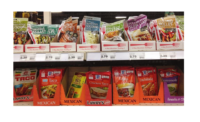Packaging Realization
How to successfully transition your concepts from ideal to real.

A well-coordinated realization process ensures that creative concepts are translated to flawless execution, creating packaging with shelf impact.

Brand managers need a packaging process that is easy to manage and yields quality results within budget limits and tight deadlines.

It is vital to ensure that when all products are assembled on shelf they are consistent in their brand representation to the consumer.



Consumer packaged goods companies (CPGs) are continually searching for effective ways to break through the clutter and connect with consumers. Packaging is the one medium they can count on to provide consistency, clarity and reach in achieving that objective.
With ever-increasing responsibilities, brand managers need a packaging process that is easy to manage and yields the quality results they are looking for within tight budgets and timelines. These companies are also keenly aware of the consequences of discovering missteps or errors after the product is on the shelf. Missing regulatory requirements, copy errors and product codes that won’t scan correctly can result in costly print reruns and retailer fines. Brand messaging and design intent can also get lost in translation through inconsistent design application and printing issues that cause a loss of shelf presence, brand confusion or—even worse—lost product sales.
To avoid these situations, it is important for you, as a brand manager, to follow these critical steps and checkpoints at each phase of the packaging process: ideation, realization, production and prepress. It’s just as important for you to understand the roles of your teams within each phase.
Many times, your ideation team may be separate from your realization team—sometimes not. Regardless, the activities these teams perform require different knowledge and skill sets. For example, ideation is more “big picture” branding and impact while realization is about design detail and consistency as it moves toward prepress and production.
Let’s take a walk through the entire process. For our purposes, the ideation and realization teams are separate.
Understanding Ideation
This phase begins with your ideation team building its understanding of the product, brand and market, and how these concepts relate to and influence engineering, structure and graphics. The goal is to build the ideal method to leverage branding and package design in communicating the key differentiation points and product features to the consumer.
This may involve extensive research which helps to build the brand strategy and develop a brand architecture that can be extended into initial package design concepts. Determining structural design, brand positioning, naming and logo development, colors, graphics and photo styling are all part of the ideation phase—generally resulting in idealized design options of the primary package display panel.
We say idealize because the ideation team is working to create impact—and not concern itself with the specifics of how that impact is achieved in production, which comes later. Concept testing is beneficial during this phase depending on the size and type of project, to gain consumer insight on a design best suited to deliver the intended brand and product message.
Once you and your team choose a design, there should be no further consideration of change in objectives or direction. It is critical to come to this conclusion before proceeding to design realization. The concepts are considered “design frozen” at this point with design masters set up for primary display panels on each package type or significant size variation. Along with these masters, your team should develop visual guidelines that include fonts, colors, graphics, photo styling and print specifications to ensure the design intent is understood when applied across all package SKUs.
Details of Realization
The details of the realization phase are often overlooked in the packaging creative process, and so is the critical role it plays in ensuring the consistency and continuity of a brand on shelf and in building brand loyalty.
So, what is realization and how does it “fit” in the packaging process? It’s the fulfillment of the ideation process or moving a design concept out of an ideal state to a real state. The ability to key in on the aesthetic and design cues from the ideation process and adapt the master design across all SKUs is central to effective realization.
Whether the format is a carton, bag, tube or tub, each requires its own unique production methodology. Whatever the application, it’s vital to maintain the brand aesthetics and integrity that you signed off on in the ideation phase. It’s critical that members of your realization and ideation teams begin communicating with each other during the concept development to ensure that all parties understand the scope and complexity of the assignment being undertaken. That said, things are not always ideal in the real world. So at the very least, once the ideation phase is complete, there should be a handoff meeting between the ideation team and the realization team to review masters, brand guidelines and design intent.
Stop Before Entering
Entering into the realization phase requires a high degree of expertise, preparation, organization and accountability, especially when you are managing realization across a product line with multiple SKUs. You, as the brand manager, need to complete and make available to the realization team copy, translations, visuals, die drawings and legal or regulatory requirements and specifications. You should do this prior to beginning realization to achieve an accurate projection of content, layout and package organization. It’s critical to make sure an approval process is in position and working as you move from phase to phase in the process.
There are three primary functions the realization team performs to successfully transfer the master concept to all packaging SKUs:
- Face Panel Adaptation - The team adapts the original master design to all face panel sizes and formats throughout the entire product line, leveraging brand equities and design guidelines. During this phase, it is important to identify and resolve situational or specialized adaptations that may be required to ensure visual balance and brand consistency on all packages.
- Full Package Adaptation - Full package designs are rolled out across various structural and size configurations, taking into consideration the specific reproduction issues that may apply based on the printing processes used. Design refinement and application to all package panels occurs while incorporating the correct legal and regulatory content, making sure all elements are sized and positioned appropriately. Often, physical mock-ups or 3D renders are done in this phase to ensure all graphics are positioned correctly across the full package. New photography is also done in this phase, if not already completed as part of ideation, as well as any necessary photo retouching.
- Promotional Adaptation - If not considered during ideation, it will be necessary for your team to develop and incorporate violator or promotional treatments into the package design hierarchy. The treatment of any violator or promotional content should never cloud the design intent of the package, yet it should always quickly and easily convey messaging and capture consumer attention.
It is important to have ongoing review and strategy discussions with your downstream partners (prepress and printers) throughout the realization process to ensure the final product is executed with maximum quality and minimum difficulty. This will also ensure that the final product remains focused on the objective of “what is designed is what is produced.” By including prepress and printers into the review and strategy process early enough you can identify and overcome production issues—avoiding costly rework, missed timelines and, most importantly, compromising the integrity of the finished package.
Production and Prepress
These phases begin as the realization process comes to a conclusion. They include the review and release of final artwork to your production teams (this is usually a conference call or meeting called a PrePro or pre-production meeting). Regardless of where the work is prepared for final print, your realization team works with its production partners to communicate and achieve consistent color and image reproduction standards.
This will confirm whether products are in cartons, bags, tubes or tubs, and these standards are consistently delivered in all packaging applications. This is vital to ensure that when all products are assembled on shelf they are consistent in their brand representation to the consumer. Each production partner will then work with your internal teams to meet the technical expectations specific to their processes and logistical demands—hopefully without unanticipated and costly revisions.
A well-coordinated realization process ensures that unique and innovative creative concepts are translated to flawless execution, creating shelf impact and delivering packaging that is on time and within budget. Recognizing the time and expense you, as a brand manager, put into creating the perfect design concept to express your brand, it is equally important to work with a realization team that can bridge that creativity into reality with the same vision. Realization requires a unique ability to live in and use the language of both the creative and the production “worlds” as your brand design is shepherded to shelf.
Looking for a reprint of this article?
From high-res PDFs to custom plaques, order your copy today!








